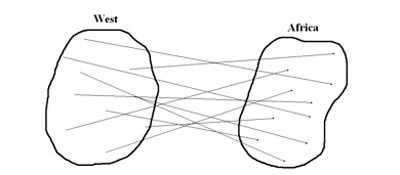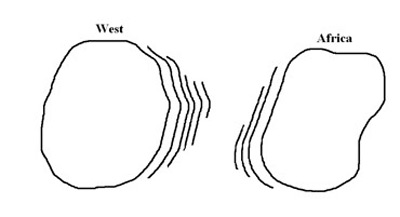Recent decades have seen radical changes in mission methodologies. Talk has turned to partnership. Increasing numbers of short-term missionaries from the West offer weeks, months, or even a few years of their lives in service. This essay explores some of the implications and outcomes of three approaches (models) to “mission” in Africa in particular, and then makes suggestions for adjustments.
The partnership model is taken as that in which a direct link is made between a Western church or organisation and an African partner. The cooperation model concentrates on the building of bridges of intercultural understanding leading to contextualised mission. The vulnerable model emphasises the need for open communication within intercultural mission relationships.
Partnership Model
The partnership model for mission appears to have arisen in an attempt to overcome paternalism and neocolonialism1 following “an emphatic demand from people in the Two-Thirds World to their right of self-determination, coupled with an insistence that they remain connected to the West, albeit on different terms than have been obtained here before.”2 Instead of Western missions “running the shop” in Africa (i.e., “the traditional missionary mentality carrying the image of a parent-child relationship”3), the West is to be a helper, facilitator, or a junior party in a partnership agreement, offering expertise to “oil the wheels” of a process that would anyway be happening in its absence. That type of expertise has tended to be financial and technical.4
The communication revolution, which allows almost immediate and constant contact, has extended this model significantly. Today, numerous churches and individuals in the West can enter into partnership with African churches and ministries. This situation is illustrated in Figure 1 below.
Figure 1. Intercultural Partnerships
 |
Someone from almost any geographical location in the West can enter into partnership with almost any of a wide range of African individuals, churches, or groups. The prevalence of European languages in Africa has aided this process. For many, this has been a liberating and invigorating model. In the West, a church can engage in frontier mission across a vast cultural divide while bypassing somewhat cumbersome “tradition bound” mission structures. A church is free to make almost any kind of arrangement with its partner, thus local churches are also empowered. Meanwhile, among the benefits for the African is direct contact with a wealthy potential donor who, not being hardened by previous contrary experiences, can prove to be financially helpful. ![]()
|
|
Unfortunately, the partnership model of missions also has serious shortfalls. One is its aversion to learning. Because partners listen to each other, Western churches entering into partnership with Africans will attend to the latter relationship more than listen to the voices of experienced fellow missionaries. According to Robert Reese, “Under the title of partnership, local churches or associations have been able to circumvent established missionary policy based on field experience.”5
The partnership model makes implicit assumptions about cultural differences; it assumes those cultural differences will not be a serious hindrance to communication, and that culturally diverse people can enter into meaningful and helpful joint activity. While being a means of crossing cultural as well as geographic gulfs (with all the benefits and excitement that this engenders), it does so, I want to argue, on the assumption that the cultural divide is inconsequential. It assumes, in other words, that the best—if not only—advisors on what should be done and how it can be done are the members of the partnership. That is, that the Western partner needs to be guided primarily by the African partner and vice versa.
Were the two partners of the same or similar culture, then one would not expect advice from one “partner” to be much different from another. But in this cross-cultural situation, it may be different. What is the African to do if the advice coming from the westerner makes little sense?
What is the westerner to do if the advice from the African seems counter-rational? There will be a limit to how often they can simply reject such advice without putting at risk the very partnership that they have worked so hard to achieve, and very likely have already so publicly acclaimed. Instead, each side can end up working on the basis of very limited understanding.
A connected question relates to multiple-partner arrangements. Unless an exclusivity clause is included in the agreement made, an African church can, for example, enter into partnership with more than one Western church or mission. (Is it right to include exclusivity clauses? If they are included, will they be kept to?) But then, how will those groups relate to one another? Their being closely related culturally (being fellow westerners) means that it will be easier for them to understand one another than to understand the African. But if they cooperate and this cooperation is not initiated and guided by the African, it would seem to be contravening at least the spirit of the agreement they have entered into.
So then, given the difficulties an African would have in creating relationships between such groups of “foreigners,” interaction between fellow missionary groups can be at least strained, and even tense or hostile. I have explored this in more detail elsewhere.6
Arrangements labelled as partnerships in which one side donates a disproportionate amount of resources can be a concealed form of paternalism.7 Partnerships are effective in situations in which there is a high degree of mutual understanding and where aims are held in common. This may not always apply in relations between Western and African churches. Dialogue does not in itself create mutuality.8 Partnerships are easy to form, and can just as quickly disintegrate. The former is often proclaimed with a trumpet blast, but the latter embarrassingly swept under the carpet. Such concealing of failure of such partnerships can hinder the establishment of effective learning curves on the development of such relationships. ![]()
Cooperation Model
An alternative to the above is the cooperation model. That is, cooperation between Western churches in their efforts to reach out to Africa. Partnerships are between people of vastly different cultures, whereas cooperation (as I am here defining these terms) is between people of similar cultures. One would hope that such cooperation would be mirrored on the African side. Whereas partnerships can be likened to an adventurous crossing of choppy waters from one island to another in a raft (Figure 1), cooperation is like building a bridge (Figure 2). By this I mean a bridge of understanding which links people with disparate worldviews, and not primarily a bridge aimed to bring about an exchange of personnel.
Figure 2. Cooperation and Moving toward Bridge-building
 |
Bridge-building is here seen as a way to reduce or (eventually) close the gap between Africa and the West. As in constructing a physical bridge over a wide gulf, this is an involved and complex affair requiring considerable cooperation. Acknowledging the need for a bridge is accepting that there is a gulf to be crossed (that is, that there is real difference).
Acquiring cultural and linguistic understanding is the bread and butter of this building process that eventually enables helpful intercultural communication. Building the bridge requires experts (and novice participants who will pay attention to those experts). It is not practical for every individual or church to build their own bridge alone.
I suspect, however, that many of today’s generation may have rejected this option. Many westerners do not simply want to learn “about Africans” from experts in classrooms—they want to meet them face to face and talk to them one on one. Today’s society has an aversion to top-heavy reliance on experts who may also be seen as not always agreeing among themselves. African people themselves may also prefer that communication be direct between themselves and the Western public—not only through mediators or cultural brokers. ![]()
My response to this rejection is two-fold:
1. The partnership model is not working. Failures are constant, but often complex and almost invariably hidden by those who are trying to avoid adverse publicity.
2. In some cases, experts are acquiring their expertise through misguided means. For instance,
- Assumptions made in research about language and translation have been far too simplistic. Scholars have been wrong to assume that a particular language of a particular people and culture can accurately represent another people and culture to them.
- The spread of European languages across Africa has resulted in increasing numbers of Western “experts” operating and thus acquiring their learning through the thin, fluid, and imprecise means as international languages.9
- Westerners living and working in Africa invariably having a role of “donor” (i.e., patron) in respect to the communities they are reaching means that they are usually not privy to insights that may discourage donations. That is, much of African life is kept concealed from experts who are also donors.
- The use of over-simplified quantitative research methodologies in formal research in Africa by the West has tended to confirm misconceptions.
These means, which I believe are faulty, have contributed to the unpopularity of the cooperation model, which has in turn resulted in the popularity of the partnership model. Replacing cooperation with the partnership model has unfortunately not resolved issues, but rather kept them out of sight.
Cooperation between missionaries is important. Learning from experience must be better than repetition of errors. Claiming to express Christian love to culturally-distant African people while ignoring one’s fellow westerner working in the same field results in poor Christian testimony.
In summary, the weaknesses of “partnership” models of mission are that they result in tensions if more than one group gets involved, they may be a cover for what is actually paternalism, and they encourage repetition of errors by discouraging learning from experience. The alternative “cooperation” model, on the other hand, does not provide sufficient opportunity for face-to-face meetings and the building of inter-cultural relationships. ![]()
Vulnerable Model
The weaknesses of both the partnership and the cooperation model can be overcome if combined with a third model of vulnerable mission. This model advocates that mission be done in the language of the people being reached, without outside subsidy for whatever ministry is engaged in.
The vulnerable missionary entering into ministry on a basis other than that of material provision cancels most of the disadvantages of the partnership model. Paternalism cannot be a part of this model if there is no lever or influence, such as finances. In this model, “success” depends on the use of wisdom instead of foreign finance, meaning that those seeking to enter into cross-cultural ministry will be keen to benefit from the experience of others. Not investing funds into a project by an African church will avoid clashes with other Western churches that support apparently conflicting aims. Because finance is not at stake, African Christians will be more honest with their Western partners.
Face-to-face meeting will not need to be discouraged if Western parties agree not to try to force their position. Because relationship is openly accepted as being part of a learning experience and not to be entered into for the purpose of planning funded projects, there will be no embarrassing loss of funds should things go wrong. Vulnerability to the people, financially and linguistically, will ensure that “experts” are properly informed.
What vulnerable mission does not do is to claim to bring “development” in the traditional sense of the word. That is, it takes social and economic development as being something that arises from a people themselves, and not from outside investment. It takes a knowledge of God as being “empowering” itself, and not requiring a boost from the Western scientific and economic apparatus. The approach of the people being reached with the gospel to the globalising world is left up to them. The missionary can give advice, but only if it is wanted.
Problems in the cooperation model that “partnership” has attempted to resolve are here found to have been rooted in over-simplistic assumptions of intercultural communication that are resolved if either of these models are implemented using the principles of vulnerable mission.
Both partnership and cooperation need to be honed by serious attention to being vulnerable in the areas of missionary finances and linguistics.
Endnotes
1. See Rieger, Joerg. 2004. “Theology and Mission between Neocolonialism and Postcolonialism.” In Mission Studies: Journal of the International Association for Mission Studies 21(2): 201-227.
2. Skreslet, Stanley H. 1995. “The Empty Basket of Presbyterian Mission: Limits and Possibilities of Partnership.” In International Bulletin of Missionary Research 19(3): 98-104. (electronic edition)
3. Helender, Eila and Wilson B. Niwagila. 1996. The Partnership and Power: A Quest for Reconstruction in Mission. Usa River, Tanzania: Makumira Publications (Number seven). 12.
4. See Lauber, Ed. 2001. “The Effect of Western Materialism on Partnership.” In Ethno-Info 49: 2-7.
5. Reese, Robert. 2005. “Dependency and Its Impact on Churches Related to the Baptist Convention of Zimbabwe and the Zimbabwe Christian Fellowship.” PhD thesis. Mid-America Baptist Theological Seminary.
6. Harries, Jim. 2008. “’Partnership’ and Inter-missionary Conflict in African Context: A Look at Contemporary Mission-team Practice.” Unpublished article.
7. Van Rheenen, Gailyn. 2001, “Money and Missions (revisited).” MMR#13 http://vlib.anthotech.com/bin/jump.cgi?ID=1077.
8. Harries, Jim. 2008. “Intercultural Dialogue—An Overrated Means of Acquiring Understanding Examined in the Context of Christian Mission to Africa.” In Exchange: A Journal of Missiological and Ecumenical Research. 37(1).
9. This can be “like a thin wash, marvelously fluid, but without adequate base.” Steiner, George. 1998. After Babel: Aspects of Language and Translation. Third Edition. Oxford: Oxford University Press. 494.


